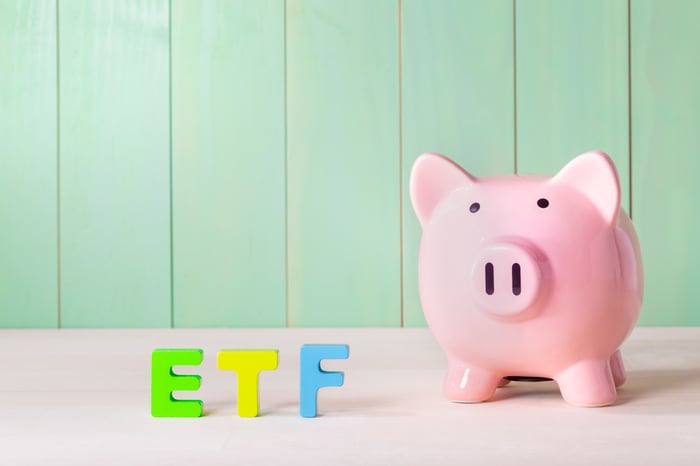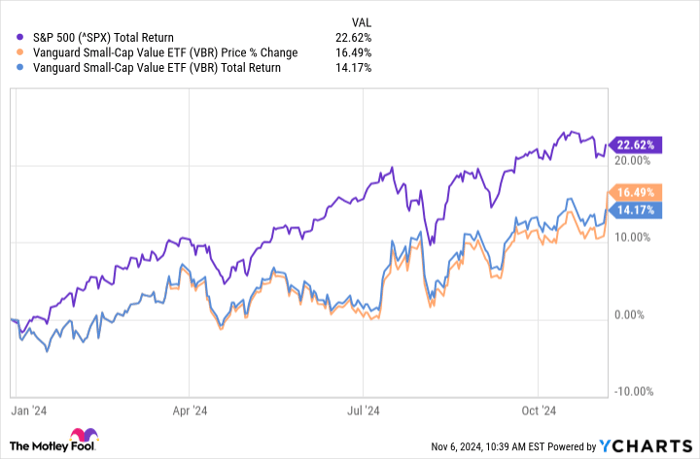Investing in stocks and bonds can be straightforward, especially with the rise of exchange-traded funds (ETFs) over the past three decades. ETFs offer a simple way to achieve diversification across various sectors or to focus on specific investment themes.
However, the costs associated with these funds can vary significantly. The average expense ratio for ETFs is around 0.52%, so investors pay $52 for every $10,000 invested annually. In contrast, Vanguard ETFs typically feature expense ratios 83% lower than this average, making them an attractive option for cost-conscious investors.

Image source: Getty Images.
Let's explore two growth-oriented Vanguard ETFs that appear poised to deliver superior results to the S&P 500 over the next five years.
An intriguing value play
Despite its "small-cap" moniker, the Vanguard Small-Cap Value Index Fund (NYSEMKT: VBR) focuses on mid-sized companies with a median market cap of $7.5 billion that seem undervalued, based on the fund's criteria. This fund aims to replicate the performance of the CRSP U.S. Small-Cap Value index and charges a remarkably low expense ratio of just 0.07%.
Over the prior 10 years, the Vanguard Small-Cap Value Index Fund has achieved an annualized return of 8.94%. The fund currently holds shares in 835 companies across all sectors of the global economy. Among its notable holdings are Smurfit WestRock plc, a leader in sustainable packaging, Builders FirstSource Inc., a key supplier of building materials, and Booz Allen Hamilton, a consulting firm known for its expertise in technology and analytics.
While the Vanguard Small-Cap Value Index Fund has performed reasonably well in 2024, it hasn't kept pace with the red-hot S&P 500, primarily due to the strong performance of large-cap technology and biopharmaceutical stocks. However, as the Federal Reserve continues its planned rate cuts, the economic environment may become more conducive to smaller, growth-oriented companies.
Lower interest rates can lead to reduced borrowing costs for businesses, which may encourage investment and expansion. Additionally, lower rates can stimulate consumer spending, benefiting smaller companies that rely on domestic demand for their products and services.
Moreover, the average annual earnings growth rate for the companies within the Vanguard Small-Cap Value Index Fund stands at an impressive 12.9% over the last five years, underscoring their strong earnings power.
Furthermore, the fund's holdings have an average price-to-earnings (P/E) ratio of just 16.1, which is significantly lower than the S&P 500's average P/E ratio of nearly 27.3. This fact suggests that these smaller companies may be undervalued and could see their stock prices rise as investors recognize their growth potential.
Overall, the Vanguard Small-Cap Value Index Fund offers exposure to a diverse array of undervalued growth opportunities at an exceptionally low cost, making it a compelling choice for long-term investors.
This large-cap growth fund is a proven commodity
The Vanguard Growth Index Fund (NYSEMKT: VUG) targets mega-cap companies with a median market cap of $1.4 trillion that exhibit above-average growth potential. Designed to track the performance of the CRSP U.S. Large Cap Growth index, this fund features an attractive expense ratio of 0.04% and has delivered a remarkable 10-year annualized return of 15.1%.
The Vanguard Growth Index Fund currently holds shares in 183 companies, many of which are leaders in the technology sector. The fund's largest holdings include tech stalwarts such as Apple, Microsoft, and Nvidia.
The Vanguard Growth Index Fund's tech tilt has allowed it to slightly outperform the broader S&P 500 index this year. However, this trend of outperformance is nothing new.
Over the prior 10 years, the Vanguard Growth Index Fund has achieved total returns of 319%, assuming reinvestment of distributions in a tax-advantaged account. By comparison, the S&P 500 has returned 243% during the same period, highlighting the fund's superior growth profile.
Although the Vanguard Growth Index Fund carries risks typical of growth investing, it has consistently proven to be a strong performer in both bull and bear markets.
The fund's emphasis on high-growth companies makes it an appealing option for risk-tolerant investors on the hunt for outsized gains. And its ultra-low expense ratio further enhances its attractiveness, allowing investors to retain a larger portion of their returns over time.
Why these two Vanguard ETFs could deliver market-beating returns
Both the Vanguard Small-Cap Value Index Fund and the Vanguard Growth Index Fund offer compelling opportunities for investors looking to enhance their growth portfolios. These two Vanguard ETFs not only feature low costs but also possess strong potential for significant long-term growth.
The Vanguard Small-Cap Value Index Fund is positioned to benefit from a favorable economic environment as interest rates decline, which can stimulate consumer spending and investment in smaller companies. With a lower average price-to-earnings ratio, compared to the S&P 500, these undervalued stocks have considerable room for appreciation as the market recognizes their potential.
On the other hand, the Vanguard Growth Index Fund focuses on large-cap companies with robust growth prospects, particularly in the technology sector. As innovation continues to drive economic growth, these companies are likely to outperform the broader market. The fund's historical performance, with a strong track record of returns, further supports its potential to exceed the S&P 500's performance over the next five years.
Don’t miss this second chance at a potentially lucrative opportunity
Ever feel like you missed the boat in buying the most successful stocks? Then you’ll want to hear this.
On rare occasions, our expert team of analysts issues a “Double Down” stock recommendation for companies that they think are about to pop. If you’re worried you’ve already missed your chance to invest, now is the best time to buy before it’s too late. And the numbers speak for themselves:
- Amazon: if you invested $1,000 when we doubled down in 2010, you’d have $23,324!*
- Apple: if you invested $1,000 when we doubled down in 2008, you’d have $42,133!*
- Netflix: if you invested $1,000 when we doubled down in 2004, you’d have $420,761!*
Right now, we’re issuing “Double Down” alerts for three incredible companies, and there may not be another chance like this anytime soon.
*Stock Advisor returns as of November 4, 2024
George Budwell has positions in Apple, Microsoft, and Nvidia. The Motley Fool has positions in and recommends Apple, Microsoft, Nvidia, and Vanguard Index Funds - Vanguard Growth ETF. The Motley Fool recommends Booz Allen Hamilton and recommends the following options: long January 2026 $395 calls on Microsoft and short January 2026 $405 calls on Microsoft. The Motley Fool has a disclosure policy.
The views and opinions expressed herein are the views and opinions of the author and do not necessarily reflect those of Nasdaq, Inc.




